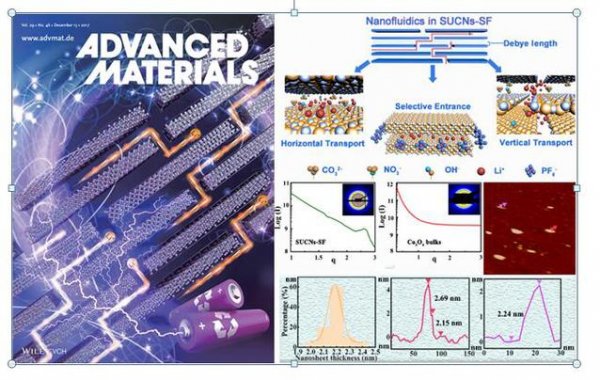The energy conversion material team led by Professor Chen Gang of the School of Chemical and Chemical Technology has made important progress in the research of anode materials for lithium-ion batteries. The research results were published in the top journal of materials science, Advanced Materials (influence factor 19.79), and the topic of the paper was "Building 2D Nanofluidic Channels for Superior Electrochemical Energy Storage" (Engineering 2D Nanofluidic Li-Ion Transport Channels for Superior Electrochemical Energy Storage). This article was selected as the front cover article (Front Cover). Prof. Chen Gang is the author of the article. Dr. Yan Chunshuang and Lu Chade, team doctoral students, are the first authors. Our university is the first communication unit. In recent years, due to its high energy density, long cycle life, and environmental friendliness, lithium-ion batteries have gradually become the mainstream power source for portable electronic devices, and are considered to be most applicable to the drive devices of electric vehicles and hybrid electric vehicles. The power of the foreground. In addition, lithium-ion batteries can store and convert solar energy, wind energy, and other green energy sources to alleviate the discontinuity and instability of the above-mentioned green energy sources, and achieve a balance between energy supply and demand. At present, in many fields, the demand for lithium ion batteries is increasing day by day. The capacity of traditional electrode materials and the rapid charge and discharge capability have reached a bottleneck. It is imminent to develop electrode materials with high rate performance to meet efficient and rapid energy storage and output. Chen Gang's team took the lead in proposing the introduction of 2D nanofluidic structures into cobalt oxide anode materials to improve the material's rate capability. The team prepared nano-sheets modified with anionic groups on the surface by a simple sol-gel method. These modified groups promoted the assembly of nano-sheets into a stack of layers that can be self-supporting. The spacing of the nanosheets is slightly less than twice the Debye length of lithium ions and can provide two-dimensional fluidic channels for lithium ion transport. The negative wall of the channel wall will selectively attract lithium ions, repel negative ions, and accelerate lithium ion transport. Through electrochemical tests, it was found that the ionic conductivity of the fluid channel nanosheets was increased by several orders of magnitude compared to the bulk materials, and the battery's rate performance was greatly improved. The research work indicates a new direction for effectively improving the rate capability of the electrode material, and provides a new exploration idea for constructing a high-power, high-stability lithium ion battery. The research work was supported by the cooperation of the National Natural Science Foundation of China and Professor Yu Guihua of the University of Texas at Austin. Prof. Chen Gang's research team is devoted to the research of new energy conversion functional materials. In 2017, he published more than 20 high-level research papers in advanced materials, advanced functional materials, and nano energy, including 1 ESI hot paper. Cited two papers. The research team won the 2017 Innovation and Entrepreneurship Scholarship for Industry and Technology and the "Top Ten Graduate Students Team" of HIT. The first author of the thesis, Dr. Yan Chunshuang, a 13th Ph.D. student, published 8 SCI papers as the first author, of which 4 were impact factors greater than 10, total cumulative influence factor was greater than 70, and were awarded Baosteel Outstanding Student Award, Chunhui Innovation Achievement Award, and Postgraduate State Scholarship. And was named the top ten graduate students of HIT. (Chemical/Text) Motorcycle Parts ,Motorcycle Accessories,Motorcycle Spare Parts,Motorbike Parts NINGBO DEMY (D&M) BEARINGS CO.,LTD , https://www.demybmtbearing.com